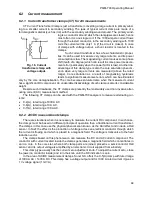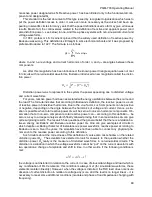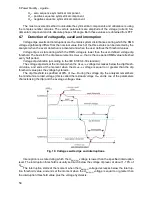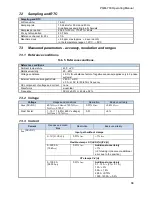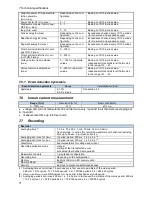
PQM-700 Operating Manual
58
vectors can be resolved to three groups of vectors: positive sequence, negative sequence and zero
sequence.
Fig. 18. Example of determination of positive sequence component.
As an example, let us use the calculation of voltage positive sequence component.
𝑈
+
=
1
3
(𝑈
1𝐴
+ 𝑎𝑈
1𝐵
+ 𝑎
2
𝑈
1°𝐶
)
where:
U
+
is the vector of positive sequence component ,
U
1A
,
U
1B
,
U
1C
are vectors of positive sequence components of phase-to-neutral voltages
U
A
,
U
B
,
U
C
𝑎 = 1𝑒
𝑗120
°
= −
1
2
+
√3
2
𝑗
𝑎
2
= 1𝑒
𝑗240
°
= −
1
2
−
√3
2
𝑗
Fig. 18 shows a graphical representation of determination of this component. As we can see
from the definition, the vector of positive-sequence component equals one third of the sum of the
summands
U
1A
, aU
1B
, a
2
U
1C
.
Operators
a
and
a
2
are unit vectors with angles 120
and 240
. The
procedure is as follows: turn the voltage vector
U
1B
by 120
counterclockwise (multiply by a) and
add to the vector
U
1A
. Then, turn the vector
U
1C
by 240
and add to the previous sum of vectors. As
a result, you get the vector 3
U
+
. The vector U
+
is the symmetrical positive sequence component.
Let us note that in case of a perfect symmetry (equal voltages and angles), the positive sequence
component is equal in terms of value to the phase-to-neutral voltages.
The positive sequence component is a measure of similarity of the tested set of three-phase
vectors to the symmetrical set of positive sequence vectors.
Analogously, the negative sequence component is a measure of similarity to the symmetrical
set of negative sequence vectors.
The zero sequence component exists in the systems in which the sum of three voltages (or
currents) is not equal to zero.
A measure of the system unbalance which is widely used in the power generation is the negative
sequence and zero sequence unbalance (formulas are for the voltage).
𝑢
0
=
𝑈
0
𝑈
1
∙ 100%
𝑢
2
=
𝑈
2
𝑈
1
∙ 100%
where: u
0
– zero sequence unbalance,
u
2
– negative sequence unbalance,
Summary of Contents for PQM-700
Page 85: ...85 Notes...

